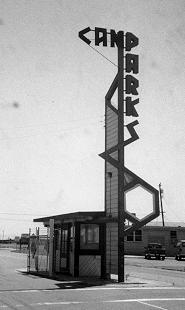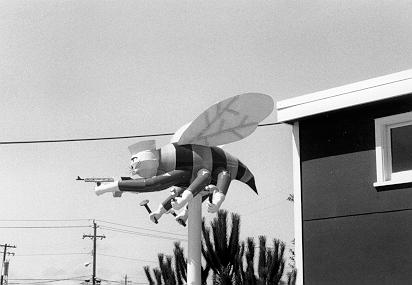Seabee
History
Main Page
Seabee Log Index
Today's Seabees
Home
Offsite links
Museum
Seabee Veterans
Official
History
Marvin
Shields
Brown Grass and Rolling Hills
Camp Parks Continues
its Military Training Mission
By Steve Karoly
 "Camp Parks … has grown
from a muddy expanse to a huge naval training and
replacement center and has taken its place as a vital
unit in the Navy’s Seabee program …. Today ¾ on
its huge paved parade ground ¾
Camp Parks can muster
more than 20,000 men and hundreds of officers." That
is what the Camp Parks cruisebook said in 1945.
"Camp Parks … has grown
from a muddy expanse to a huge naval training and
replacement center and has taken its place as a vital
unit in the Navy’s Seabee program …. Today ¾ on
its huge paved parade ground ¾
Camp Parks can muster
more than 20,000 men and hundreds of officers." That
is what the Camp Parks cruisebook said in 1945.
Few structures remain from Camp Parks’ Seabee days. Among them, according to Camp Park’s Public Affairs Officer Lynn Schaak, are the base commanders house, which overlooks the base from the top of a hill, and the art deco-style sign at the main gate on Dougherty Road in Dublin, California.
All else is gone. The World War II buildings were razed after the war. Even the street numbering sequence changed to suit the Air Force. Surviving buildings are Korean War vintage, the streets are named after Air Force heroes and Congressional Medal of Honor awardees and hundreds of Army trucks fill a dozen motor pools.
But drive south from the main gate on 5th Street and what do you see? Nothing but a vigilant Fighting Bee guarding Camp Parrington, home to Detachment D of CBMU 303. The camp, consisting of a small building at the northwest corner of 5th Street and Fernandez Avenue, became home to the Bay Area Seabees two years ago after Naval Station Treasure Island closed.
And that is not all. If you look closely into the building across the street, you will spy a dungaree-clad Seabee lounging on his white canvas hammock. Nearby copies of the Camp Parks Log suggest that this Seabee is catching up on news of his fellow Seabees after a wearisome day training. His "sweetheart" pillow reminds him of his loved ones back home.
This scene is found in the History Center of the Parks Reserve Forces Training Area¾the current designation for Camp Parks. Visitors can marvel at artifacts from Camp Park’s three military eras. Since late 1942, Camp Parks has been home to the Navy, Air Force and Army.
Seabee exhibits sit just inside the museum entrance. Two foot lockers donated by John B. Quaccia, a chief petty officer’s olive drab utility uniform with the Fighting Bee embroidered on the left shirt pocket from the Vietnam War period and first edition copies of Camp Parks’ World War II cruise books are among Seabee artifacts at the museum.
A base for Seabees, sailors, airmen and soldiers
Commissioned on January 19, 1943 as the Construction Battalion Replacement Depot, Camp Parks functioned as home for Seabees returning from the Pacific Theater of Operations. Battalions returned to the States after a year or more of arduous construction duty. They came to Camp Parks for medical treatment, military training and reorganization.
The base housed up to 20 battalions at a time. Most battalions prepared for a second tour in the Pacific. Many Seabees were hospitalized, and those no longer fit for duty received their discharge. After leave, personnel were subjected to a rigorous training schedule. The battalions were brought back up to fighting strength.
This land-locked naval base sat adjacent to the quiet Bay Area towns of Dublin, Livermore and Pleasanton. Today, the intersection of Interstate Highways 580 and 680 is but a short distance from the southwest corner of the base. Much of the surrounding countryside is built up. Army units use some 2,300 acres north of the main camp for field exercises and weapons training. Camp Parks is located 28 miles east of Oakland, California.
East of the Seabee base, toward Livermore, Camp Shoemaker housed a Naval Hospital and Naval Training and Personnel Distribution Center. These facilities served the fleet in much the same manner as Camp Parks served the Seabees. Collectively the area was known as Fleet City.
After closing in 1946, Camp Parks sat unused until the Air Force established a basic training center in 1951. Known as Parks Air Force Base, the Air Force found it necessary to completely rebuild the base. The sea of Quonset huts and two-story wooden barracks had been dismantled following World War II. Base personnel were initially housed in temporary facilities and ate from a field mess. Training began in March 1952.
Louis Richard, Jr., a retired Air Force Master Sergeant, remembers the first group of Airmen who arrived at Camp Parks in the Summer of 1951. He said they were transported to California on a troop train that felt like a "cattle car." "You had everybody coming out [West] on that train. I came from Lackland Air Force Base."
Richard remembers finding the base in complete disarray when he arrived. He found the remaining buildings in poor shape. Otherwise, a few concrete pads were all that remained. The weeds were waist high. "The weeds were pretty high," remembers Richard. "All the lower ranking Airmen, including the cooks, were out there cutting weeds down."
Closed and transferred to the control of the Presidio of San Francisco in 1959, the base remained in standby status until December 1980 when the Parks Reserve Forces Training Area was established by the Department of the Army.
Weekend warriors train today
Today, the sprawling base’s mission is similar to its World War II mission. Thousands of National Guard and Army Reserve Soldiers — and 94 Naval Reserve Seabees — train for war at Camp Parks. One occupant, 1st Brigade of the 91st Division trains Army units using computer simulators. The base supports some 11,000 San Francisco Bay Area Army Reserve and California National Guard Soldiers from 180 units.
 |
| A restored Fighting Seabee stands guard over Camp Parrington. SKCS Ron Parry, a former member of the decommissioned NMCB 16, said it was rescued from NMCB 16's headquarters in Los Alamitos, California. One of the unit's first tasks was to strip it to bare metal, weld the rusted spots and give it a fresh coat of paint. |
Many of these units train at Camp Parks for two weeks each summer. The May/June 1998 issue of The Advisor, Camp Parks' newsletter, reported on Operation Wild Boar 98, a two-week field hospital exercise conducted by the 349th General Hospital and 921st Field Hospital.
"The ‘battle’ was fought at Fort Hunter-Liggett, where combat support hospitals were set up and first casualties cared for," The Advisor reported. "The wounded soldiers who were unable to return to battle, were transported by C-130 military airplanes from King City to Hayward Airport, and from there evacuated by helicopter to Parks for long term care." Both units set up field hospitals complete with operating rooms, patient wards and support services.
Bay Area Seabees
Although it may not be the newest unit to train at Camp Parks, Detachment D of CBMU 303 is certainly the most "historic." Camp Parrington, named after retired EOC Russ Parrington, is home to 94 Seabees Reservists. CBMU 303 is headquartered on Naval Air Station North Island in Coronado, California.
The Seabees provide a valuable service to Camp Parks. Since their mission upon mobilization is to maintain an advanced base, they train by repairing Army facilities on the sprawling base. In addition to refurbishing their own building, Building 611, last year the Seabees poured over 1,000 linear feet of new sidewalks on Camp Parks, according to Ens. John Hurlburt, OIC of the detachment. This year the detachment will construct a rappelling tower and renovate houses for the multi-service reserve base.
This story is found in No. 4 (Fall 1998) of the Seabee Log.
| Bulletin Board | Keyword Search |
| Bookstore | Links |
| About Us | Recent Additions |
![]()

